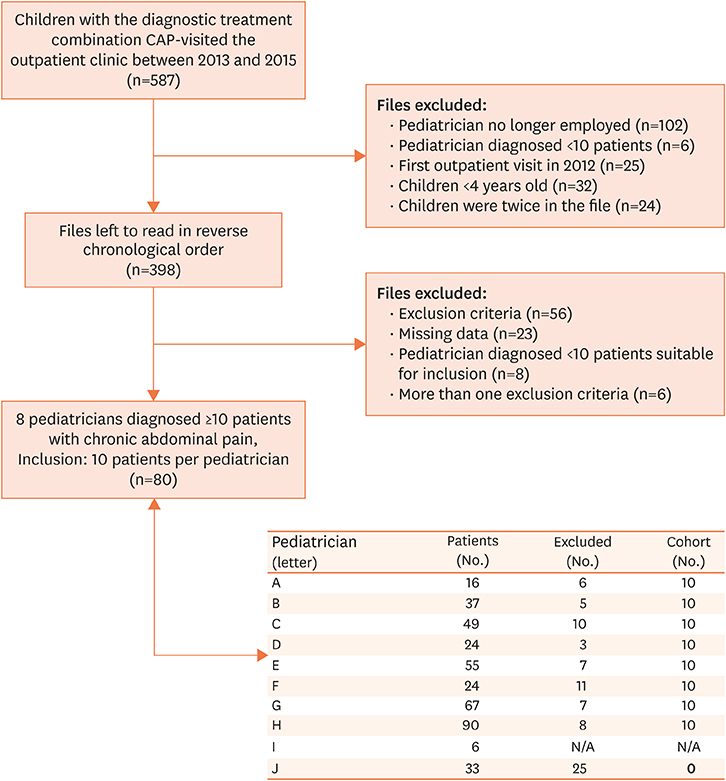Pediatr Gastroenterol Hepatol Nutr.
2019 May;22(3):225-232. 10.5223/pghn.2019.22.3.225.
Large Variation in Clinical Practice amongst Pediatricians in Treating Children with Recurrent Abdominal Pain
- Affiliations
-
- 1Department of Pediatrics, Tergooi Hospital, Blaricum, the Netherlands. fbplotz@tergooi.nl
- KMID: 2444848
- DOI: http://doi.org/10.5223/pghn.2019.22.3.225
Abstract
- PURPOSE
To evaluate intra- and inter-observer variability and guideline adherence amongst pediatricians in treating children aged between 4 and 18 years referred with recurrent abdominal pain (RAP) without red flags.
METHODS
The first part of the study is a retrospective single-center cohort study. The diagnostic work-ups of eight pediatricians were compared to the national guidelines. Intra- and inter-observer variability were examined by Cramer's V test. Intra-observer variability was defined as the amount of variation within a pediatrician and inter-observer variability as the amount of variation between pediatricians in the application of diagnostic work-up in children with RAP. Prospectively, the same pediatricians were requested to provide a report on their management strategy with a fictitious case to prove similarities in retrospective diagnostic work-up.
RESULTS
A total of 10 patients per pediatrician were analyzed. Retrospectively, a (very) weak association between pediatricians' diagnostic work-ups was found (0.22), which implies high inter-observer variability. The association between intra-observer diagnostic was moderate (range, 0.35-0.46). The Cramer's V of 0.60 in diagnostic work-up between pediatricians in the fictitious case implied the presence of a moderately strong association and lower inter-observer variability than in the retrospective study. Adherence to the guideline was 66.8%.
CONCLUSION
We found a high intra- and inter-observer variability and moderate guideline adherence in daily clinical practice amongst pediatricians in treating children with RAP in a teaching hospital.
Keyword
MeSH Terms
Figure
Reference
-
1. Baber KF, Anderson J, Puzanovova M, Walker LS. Rome II versus Rome III classification of functional gastrointestinal disorders in pediatric chronic abdominal pain. J Pediatr Gastroenterol Nutr. 2008; 47:299–302.
Article2. Hyams JS, Di Lorenzo C, Saps M, Shulman RJ, Staiano A, van Tilburg M. Childhood functional gastrointestinal disorders: child/adolescent. Gastroenterology. 2016; 150:1456–1468.e2.
Article3. Di Lorenzo C, Colletti RB, Lehmann HP, Boyle JT, Gerson WT, Hyams JS, et al. Chronic abdominal pain in children: a technical report of the American Academy of Pediatrics and the North American Society for Pediatric Gastroenterology, Hepatology and Nutrition. J Pediatr Gastroenterol Nutr. 2005; 40:249–261.
Article4. Wright NJ, Hammond PJ, Curry JI. Chronic abdominal pain in children: help in spotting the organic diagnosis. Arch Dis Child Educ Pract Ed. 2013; 98:32–39.
Article5. Rajindrajith S, Zeevenhooven J, Devanarayana NM, Perera BJ, Benninga MA. Functional abdominal pain disorders in children. Expert Rev Gastroenterol Hepatol. 2018; 12:369–390.
Article6. Yacob D, Di Lorenzo C. How to deal with pediatric functional gastrointestinal disorders. Curr Pediatr Rep. 2013; 1:198–205.
Article7. Christakis DA, Cowan CA, Garrison MM, Molteni R, Marcuse E, Zerr DM. Variation in inpatient diagnostic testing and management of bronchiolitis. Pediatrics. 2005; 115:878–884.
Article8. Florin TA, French B, Zorc JJ, Alpern ER, Shah SS. Variation in emergency department diagnostic testing and disposition outcomes in pneumonia. Pediatrics. 2013; 132:237–244.
Article9. Urkin J, Allenbogen M, Friger M, Vinker S, Reuveni H, Elahayani A. Acute pharyngitis: low adherence to guidelines highlights need for greater flexibility in managing paediatric cases. Acta Paediatr. 2013; 02:1075–1080.
Article10. Niele N, Willemars L, van Houten M, Plötz FB. National survey on managing minor childhood traumatic head injuries in the Netherlands shows low guideline adherence and large interhospital variations. Acta Paediatr. 2018; 107:168–169.
Article11. Lugtenberg M, Zegers-van Schaick JM, Westert GP, Burgers JS. Why don't physicians adhere to guideline recommendations in practice? An analysis of barriers among Dutch general practitioners. Implement Sci. 2009; 4:54.
Article12. Halm EA, Atlas SJ, Borowsky LH, Benzer TI, Metlay JP, Chang YC, et al. Understanding physician adherence with a pneumonia practice guideline: effects of patient, system, and physician factors. Arch Intern Med. 2000; 160:98–104.
Article13. Cnossen MC, Scholten AC, Lingsma HF, Synnot A, Tavender E, Gantner D, et al. Adherence to guidelines in adult patients with traumatic brain injury: a living systematic review. J Neurotrauma. 2016; 33:1–14.
Article14. Jansen PR, Dremmen M, van den Berg A, Dekkers IA, Blanken LM, Muetzel RL, et al. Incidental findings on brain imaging in the general pediatric population. N Engl J Med. 2017; 377:1593–1595.
Article15. Paul R, Melendez E, Stack A, Capraro A, Monuteaux M, Neuman MI. Improving adherence to PALS septic shock guidelines. Pediatrics. 2014; 133:e1358–66.
Article16. Nicastro E, Lo Vecchio A, Liguoro I, Chmielewska A, De Bruyn C, Dolinsek J, et al. The impact of e-learning on adherence to guidelines for acute gastroenteritis: a single-arm intervention study. PLoS One. 2015; 10:e0132213.
Article17. Redaèlli M, Vollmar HC, Simic D, Maly-Schürer C, Löscher S, Koneczny N. Guideline implementation study on asthma: results of a pragmatic implementation approach. Z Evid Fortbild Qual Gesundhwes. 2015; 109:124–131.18. Maas L, Dorigo-Zetsma JW, de Groot CJ, Bouter S, Plötz FB, van Ewijk BE. Detection of intestinal protozoa in paediatric patients with gastrointestinal symptoms by multiplex real-time PCR. Clin Microbiol Infect. 2014; 20:545–550.
Article
- Full Text Links
- Actions
-
Cited
- CITED
-
- Close
- Share
- Similar articles
-
- Pediatric Abdominal Ultrasound Training Program: Standard Views
- New approach to chronic recurrent abdominal pain in children
- Gastrofiberscopic findings and helicobacter pylori gastritis in children with recurrent abdominal pain
- The Relationship of between Anxiety Tendency and Recurrent Abdominal Pain in Elementary School Children
- Clinical Manifestations of Recurrent Abdominal Pain May Differ with Helicobacter pylori Infection in Children


